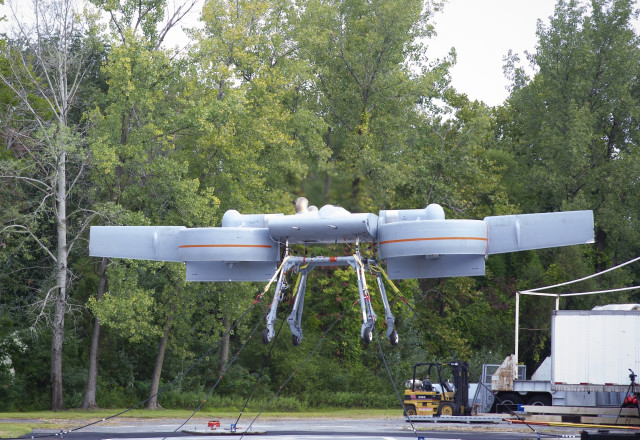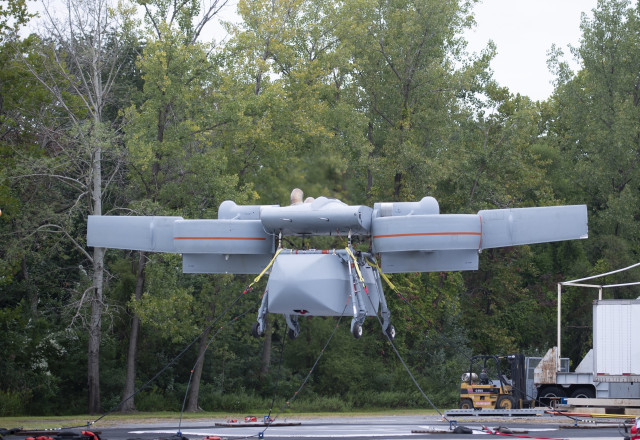Piasecki Aircraft Achieves Historic Milestone With First Flight of Aerial Reconfigurable Embedded System (ARES) Tilt-Duct VTOL Vehicle

ESSINGTON, Pa., September 10, 2024 (Newswire.com) - In an aviation milestone, Piasecki Aircraft Corporation (PiAC) successfully conducted the first flight of its innovative proof of concept tilt-duct Aerial Reconfigurable Embedded System Demonstration Vehicle (ARES-DV), marking a significant leap forward in vertical take-off and landing (VTOL) technology. The flight event, which consisted of two tethered hover flights, is the first step in a program to demonstrate the potential of ARES to revolutionize autonomous airborne casualty evacuation (CASEVAC), cargo resupply, and provide other multi-mission capabilities in support of small distributed combat units. This flight represents a commencement milestone in Piasecki’s experimental flight test program sponsored by the U.S. Air Force and Army under a $37 million Strategic Funding Initiative (STRATFI).
ARES is a modular multi-mission tilt-duct VTOL vehicle that can be operated as an unmanned aerial system (UAS) or with an optional manned flight module. ARES is designed with a small landing footprint to enable shipboard and expeditionary operations as well as provide embedded multi-mission C4I, ISR, combat, and logistics support to small, distributed combat forces operating over extended distances and in complex terrain. Rapidly reconfigurable Mission Payload Modules are supported by a common Flight Module to deliver multi-mission flexibility with significantly reduced overall logistics footprint and cost.
The ARES-DV Flight Module lifted off from Piasecki's West Helipad in Essington, Pennsylvania, on Friday, September 6, and achieved a sustained hover for a duration of approximately one minute before descending. Upon landing, the team attached the U.S. Army’s Mobile Multiple Mission Module (M4) to the ARES-DV Flight Module, and conducted a second successful one-minute hover, demonstrating the ability of its triplex fly-by-wire flight control system to sustain a stable hover in multiple configurations and a dynamic ground environment.
“Since its origins as a DARPA conceptual design project, Piasecki has led ARES through years of research and development — design iterations, rigorous component testing, system level validation, and more — to mature the technology leading up to today’s landmark achievement. ARES represents another significant milestone in Piasecki’s 80-year history of bringing innovation to flight,” said John Piasecki, CEO of Piasecki Aircraft. “I’d like to thank our Air Force and Army customers as well as our dedicated employees and partners for their continued support as we move forward with the next phases of development. After successfully expanding the aircraft’s flight envelope, we will implement modifications to enable flight demonstration of a fully autonomous CASEVAC and logistics resupply capability. Successful flight demonstration of the ARES proof of concept demonstrator significantly reduces risk and accelerates the development timeline for a family of operational tilt-duct configurations for multi-mission VTOL UAS and high-speed VTOL applications.”
“ARES creates a new baseline for VTOL technology applied to heavy-payload, time-critical logistics crucial for dispersed operations,” said Barth Shenk, Program Manager at Air Force Research Laboratory.
ARES features Honeywell Aerospace’s Compact Fly-By-Wire system, an integrated flight control system that is both lightweight and robust. Designed to fit into the limited space available on smaller aircraft, this state-of-the-art system provides safety-critical flight control capabilities typically found in much larger airliners and advanced fighter aircraft. It enables precise handling and stability across a wide range of flight conditions, thereby enhancing safety and performance — and is especially advantageous for VTOLs, where space is at a premium and weight efficiency is paramount.
“The application of Honeywell’s Compact Fly By Wire in the ARES-DV not only showcases the ability of this technology to support a future multi-mission VTOL aircraft but also the great cooperation between Honeywell and Piasecki in a fast-moving program,” said Dave Shilliday, VP & GM, Advanced Air Mobility, Honeywell Aerospace Technologies.
The hover test flight was funded by an Army SBIR Sequential Phase II contract and by an Air Force TACFI Sequential SBIR II award. In November 2023, Piasecki announced that it was awarded a $37 million multi-year contract by AFWERX, the Air Force's innovation arm, in conjunction with the Air Force Research Laboratory (AFRL) and Army Medical Research and Development Command (MRDC), as part of its Strategic Funding Increase (STRATFI) program to accelerate ARES development and flight testing, among other advanced VTOL enabling technologies.
“We are deeply grateful to all our supporters, especially the visionary leadership and commitment of AFRL and TATRC,” Piasecki added.
About Piasecki Aircraft Corporation
For more than 80 years, Piasecki has been a leader in vertical lift aircraft. It specializes in the design, fabrication, and flight testing of experimental rotorcraft and unmanned air vehicles and has developed and flown more than 25 advanced VTOL and UAV aircraft to date. Customers include the U.S. Air Force Research Lab and AFWERX; the U.S. Army Futures Command Aviation and Missile Center and Medical R&D Command; NAVAIR; DARPA; and SOCOM; as well as leading OEMs such as Lockheed Martin and Boeing. Piasecki is a recipient of numerous awards including the Presidential National Medal of Technology, the Smithsonian Air & Space Achievement Award, and the prestigious Tibbitts Award for small business innovation from the U.S. Department of Defense. Piasecki has been a proud member of the Vertical Flight Society for more than 50 years. For more information, please visit piasecki.com and follow Piasecki on LinkedIn.
Source: Piasecki Aircraft Corporation


